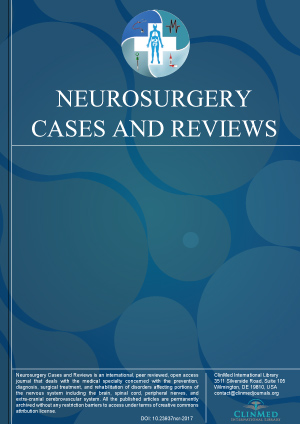Open Access DOI:10.23937/2643-4474/1710132
Dwyer Instrumentation for Scoliosis, a Challenge for Neuraxial Anesthesia: A Case Report
Sai Pentyala, MD, Mickael Marc Antoine A Khouzami, MD, Barbara Orlando, MD, PhD, Nwadiogo Ejiogu, MD, MA and Deborah Stein, MD
Article Type: Case Report | First Published: December 19, 2022
We describe the case of a patient with severe scoliosis, following Dwyer instrumentation and Harrington rods insertion during adolescence, presenting for labor analgesia. Ultrasonography in accordance with radiographic imaging was used to guide the placement of an epidural catheter, successfully used for pain control during labor in an otherwise challenging patient....
Open Access DOI:10.23937/2643-4474/1710131
Concurrent Pituitary Adenoma and Intraventricular Glioblastoma Multiforme: A Case Report and Review of the Literature
Chattrabongkot Chokaouychai, MD and Raywat Noiphithak, MD
Article Type: Case Report | First Published: December 14, 2022
Intracranial tumors of different histologic morphologies in concurrent existence are extremely rare with an incidence rate less than 0.9% among the cases of primary brain tumors. Here, we report a case of a 57-year-old male who was diagnosed with coexistence of nonfunctioning pituitary adenoma (PA) and intraventricular glioblastoma multiforme (GBM). She presented with blurred vision from pituitary tumor and right-sided weakness from intraventricular tumor. Interhemispheric transcallosal approach...
Open Access DOI:10.23937/2643-4474/1710130
Intraoperative Pulseless Electrical Activity Cardiac Arrest during Intracranial Aneurysm Clipping: Case Report
Alaa Al-Mohammad, PhD, Soghakhawari, MRCS, Will Muirhead, FRCS, Lila Dinner, FRCA and Mary Murphy, FRCS
Article Type: Case Report | First Published: November 25, 2022
Cardiac arrest is a rare intraoperative complication with few cases reported during neurosurgery. Proposed causes of PEA cardiac arrest in this setting include medications, irrigation, coronary vasospasm, and elicitation of the trigeminocardiac reflex. Here, we report the case of a 52-year- old man who suffered an intra-operative pulseless electrical activity (PEA) cardiac-arrest while undergoing elective clipping of a right MCA bifurcation aneurysm through pterional craniotomy....
Open Access DOI:10.23937/2643-4474/1710129
Anatomical Classification of Arterial Compression in Neurovascular Syndromes: Microsurgical Perspective
KUZUCU Pelin, MD, TÜRKMEN Tolga, MD, KARA Enes, MD, GÖKALP Elif, MD, YAMAN Mesut Emre and AYKOL Şükrü, MD
Article Type: Original Article | First Published: November 19, 2022
Trigeminal neuralgia, hemifacial spasm, and glossopharyngeal neuralgia are defined as neurovascular syndromes and are conditions of compression of the cranial nerves by vascular structures. The aim of this study is to make the surgical approach safer by providing aggregate data on vascular structures and their aspects that cause compression in neurovascular syndromes....
Open Access DOI:10.23937/2643-4474/1710126
FAHR's Disease and MCA Aneurysm Bleeding Case Report
Aykut İLİKHAN, Şükrü ORAL, Mehmet Berat ERTURHAN and Masud YUSİFOV
Article Type: Case Report | First Published: November 09, 2022
Fahr's disease is named after the German neurologist Karl Theodor Fahr, who first reported it in 1930. This is a rare neurological condition characterized by abnormal idiopathic calcification of the basal ganglia and is usually inherited in autosomal dominant manner. These calcifications are consisted of calcium carbonate and phosphate, and may also occur in some other locations, such as thalamus, hippocampus, dentate nucleus, cerebral cortex, and cerebellar subcortical white matter....
Open Access DOI:10.23937/2643-4474/1710124
Primary Glioblastoma of Trigeminal Root Entry Zone and Internal Auditory Canal: Case Report
Jalil Habert, ThiNgocPhuong Nguyen, MD, Emmanuel Hologne, MD, Anne Doe de Maindreville, MD, Sofiene Cheikh-Rouhou, MD and Laurent Pierot, MD, PhD
Article Type: Case Report | First Published: October 17, 2022
Glioblastoma developed from cranial nerves are extremely rare. We report the case of a 71-year-old woman with glioblastoma arising from both trigeminal root entry zones and Internal Auditory Canal (IAC) nerves. The patient presented with facial numbness and paresthesia in both trigeminal sensory territories with initial Magnetic Resonance Imaging (MRI) at 1-month follow up showing contrast enhancement and thickening of both trigeminal nerves root entry zone and moderate thickening of IAC bundle,...
Open Access DOI:10.23937/2643-4474/1710123
Case Report: Use of MLC601 in Severe Traumatic Brain Injury
Ramesh Kumar, Peh Hong Shawn and Narayanaswamy Venketasubramanian
Article Type: Case Report | First Published: October 14, 2022
Traumatic brain injury (TBI) is a major cause of mortality and morbidity worldwide. The medical management of TBI involves stabilization of the individual and focusing on preventing further injury. There are no proven pharmacological therapies to enhance recovery after severe TBI....

